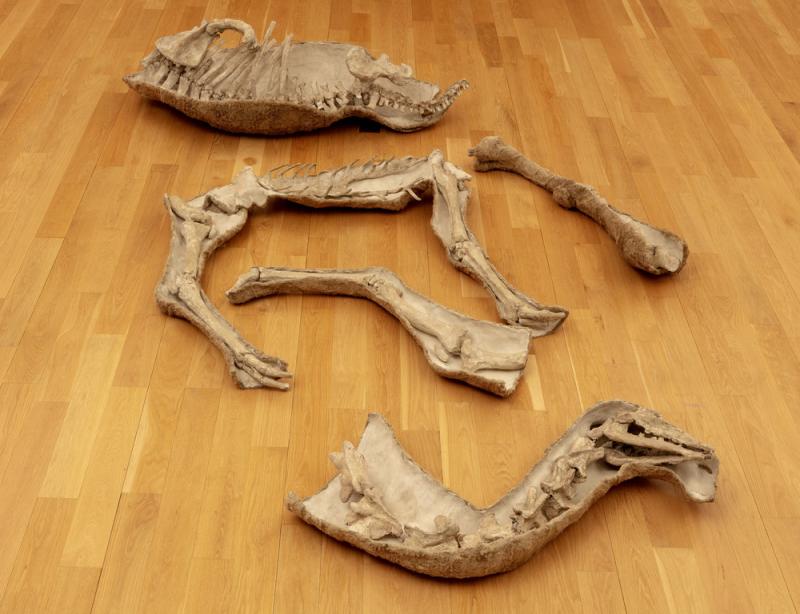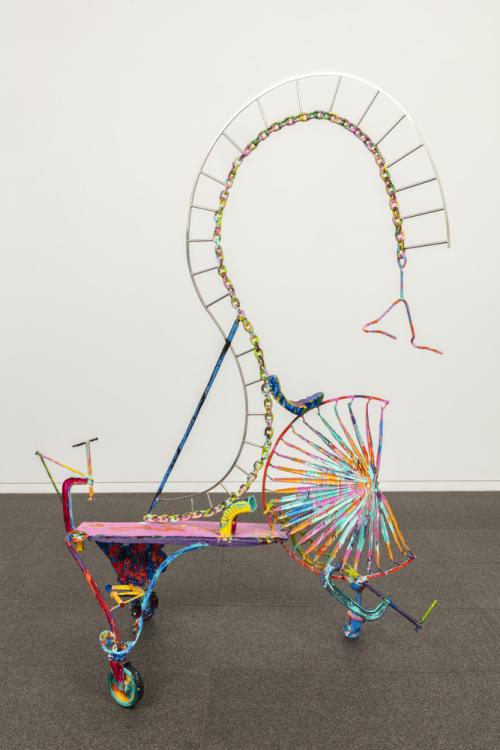Skip to main content
Inside-Outside
Artist
Nancy Graves
(Born 1939, United States; died 1995, United States)
Date1970
MediumSteel, wax, marble dust, acrylic, fiberglass, animal skin, and oil paint
DimensionsOverall: 48 × 120 × 120 in. (121.92 × 304.8 × 304.8 cm)
Credit LineCollection of the Modern Art Museum of Fort Worth, Museum purchase, The Friends of Art Endowment Fund
Object number2016.6.A-L
Status
Not on viewCopyright© Nancy Graves Foundation
Category
Label TextNancy Graves dedicated her career to exploring themes common between science and art: creation, evolution, destruction, documentation, and discovery among them. She first captured the attention of the art world in 1969, when she installed three life-size, eerily naturalistic sculptures of camels at the Whitney Museum of American Art in New York. The camels, handmade from a mix of wood, metal, polyurethane, wax, paint, burlap, and real animal hide, startled viewers and critics alike.
Graves’s work reflected a Post-Minimalist impulse, shared by contemporary sculptors Eva Hesse, Bruce Nauman, and Richard Serra, toward objects made of unconventional media that bore evidence of the individual artist’s hand, but her art was unique in its intimate connection to the natural world. With their imposing stature and highly tactile surfaces, the camels resembled taxidermy from a natural history diorama but were displayed on the floor like sculptures in the round, allowing viewers to observe their handcrafted construction up close. The state of tension the works elicited—were they accurate models or artistic inventions?—was central to their meaning.
In 1970, Graves began to present the camel in new, deconstructed forms. The Modern’s Inside-Outside, 1970, appears to be a dismantled camel skeleton scattered haphazardly across the floor. Rather than build up the animal from an inner armature outward, here the artist seemingly dissected the camel from the outside in, presenting each piece as if its “flesh” has been torn open to reveal the “bones” inside. Up close, each segment is convincingly naturalistic in its fabrication, but from a distance Inside-Outside reads also as a randomly distributed collection of abstract forms.
Graves’s work reflected a Post-Minimalist impulse, shared by contemporary sculptors Eva Hesse, Bruce Nauman, and Richard Serra, toward objects made of unconventional media that bore evidence of the individual artist’s hand, but her art was unique in its intimate connection to the natural world. With their imposing stature and highly tactile surfaces, the camels resembled taxidermy from a natural history diorama but were displayed on the floor like sculptures in the round, allowing viewers to observe their handcrafted construction up close. The state of tension the works elicited—were they accurate models or artistic inventions?—was central to their meaning.
In 1970, Graves began to present the camel in new, deconstructed forms. The Modern’s Inside-Outside, 1970, appears to be a dismantled camel skeleton scattered haphazardly across the floor. Rather than build up the animal from an inner armature outward, here the artist seemingly dissected the camel from the outside in, presenting each piece as if its “flesh” has been torn open to reveal the “bones” inside. Up close, each segment is convincingly naturalistic in its fabrication, but from a distance Inside-Outside reads also as a randomly distributed collection of abstract forms.








